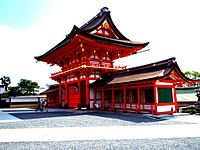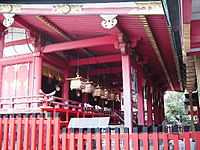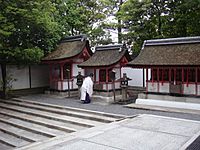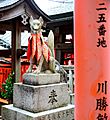Fushimi Inari-taisha facts for kids
Fushimi Inari-taisha (伏見稲荷大社) is a very important Shinto shrine located in Fushimi, a part of Kyoto, Japan. It is famous for its thousands of bright orange-red torii gates that wind up a mountain.
This shrine is the main one for Inari, who is the Japanese god of rice. Inari is also seen as the god of business and good fortune. There are more than 32,000 smaller Inari shrines, called bunsha (分社), all over Japan. Fushimi Inari-taisha is the head of all of them.
Contents
History of Fushimi Inari-taisha
Fushimi Inari-taisha has a long history. It has been connected to the emperors of Japan since the early Heian period (which started in 794 AD). This shows how important the shrine was to the country's leaders.
From 1871 to 1946, the Japanese government officially supported Fushimi Inari-taisha. It was considered one of the most important shrines in Japan during that time.
Exploring the Shrine Grounds
The shrine is known for its beautiful buildings and unique features. When you visit, you'll see many interesting things.
The Torii Gates
The most famous part of Fushimi Inari-taisha is its paths covered with thousands of torii gates. These gates are donated by people and businesses who want to thank Inari or ask for good luck. Walking through them feels like going through a tunnel of bright orange.
Fox Statues
You will see many fox statues around the shrine. Foxes are believed to be Inari's messengers. They often hold a key or a jewel in their mouths. These items represent rice granaries and good fortune.
Main Shrine Buildings
The main buildings include the rōmon (two-story gate) and the honden (main hall). These are where people offer prayers and show respect to Inari. The architecture is traditional Japanese and very beautiful.
Gallery
Images for kids
See also
 In Spanish: Fushimi Inari-taisha para niños
In Spanish: Fushimi Inari-taisha para niños

















